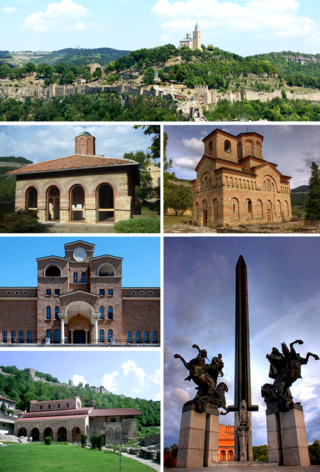
Veliko Tarnovo is a city in north central Bulgaria and the administrative centre of Veliko Tarnovo Province. It is the historical and cultural capital of Bulgaria.

Ivan Shishman ruled as emperor (tsar) of Bulgaria in Tarnovo from 1371 to 3 June 1395. The authority of Ivan Shishman was limited to the central parts of the Bulgarian Empire.
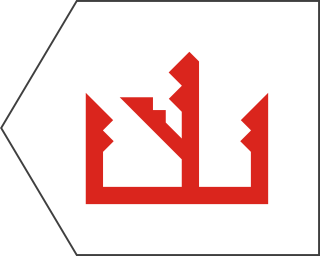
The Second Bulgarian Empire was a medieval Bulgarian state that existed between 1185 and 1396. A successor to the First Bulgarian Empire, it reached the peak of its power under Tsars Kaloyan and Ivan Asen II before gradually being conquered by the Ottomans in the late 14th century.
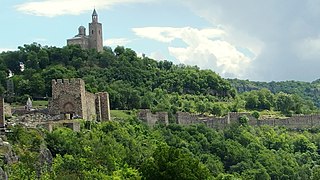
Tsarevets is a medieval stronghold located on a hill with the same name in Veliko Tarnovo in northern Bulgaria. Tsarevets is 206 metres (676 ft) above sea level. It served as the Second Bulgarian Empire's primary fortress and strongest bulwark between 1185 and 1393, housing the royal and the patriarchal palaces, and it is also a popular tourist attraction.
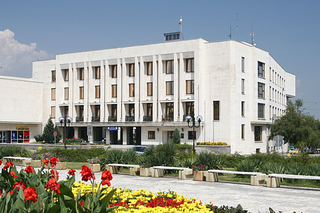
Gorna Oryahovitsa is a town in northern Bulgaria, situated in Veliko Tarnovo Province, 10 km (6 mi) from Veliko Tarnovo. It is the administrative centre of the homonymous Gorna Oryahovitsa Municipality. According to the 2021 Census, the town has a population of 27,317 inhabitants.

Arbanasi is a village in Veliko Tarnovo Municipality, Veliko Tarnovo Province of central northern Bulgaria, set on a high plateau between the larger towns of Veliko Tarnovo and Gorna Oryahovitsa. It is known for the rich history and large number of historical monuments, such as 17th- and 18th-century churches and examples of Bulgarian National Revival architecture, which have turned it into a popular tourist destination.

The stronghold of Cherven was one of the Second Bulgarian Empire's primary military, administrative, economic and cultural centres between the 12th and the 14th century. The ruins of the fortress are located near the village of the same name 30 to 35 kilometres south of Rousse, northeastern Bulgaria.

Lyaskovets is a town in central northern Bulgaria, located in homonymous municipality of Veliko Tarnovo Province, 10 km northeast of Veliko Tarnovo, 2 km southeast of Gorna Oryahovitsa and 5 km south of the Yantra River, north of the Balkan Mountains. Its name comes from the word leska ('hazel') or leshnik ('hazelnut'), because the tree was abundant in the area. As of December 2009, the town has a population of 10,314 inhabitants.

Kilifarevo is a small town in central northern Bulgaria, administratively part of Veliko Tarnovo Municipality, Veliko Tarnovo Province. Previously a village, it was proclaimed a town in 1973.

The Architecture of the Tarnovo Artistic School is a term for the development of architecture during the Second Bulgarian Empire (1185–1396). In the 13th and 14th centuries the capital Tarnovo determined the progress of the Bulgarian architecture with many edifices preserved or reconstructed which show the skills of the Medieval Bulgarian architects and the construction and decorative techniques they used. The builders have created a unique architectural style, known as Tarnovian Style, that influenced the architecture in many countries of Southeastern Europe and parts of Central Europe. With its diverse architecture, the Tarnovo School may be separated into several branches according to the function of the buildings.

The Church of Saint Demetrius of Thessaloniki is a medieval Bulgarian Orthodox church in the city of Veliko Tarnovo in central northern Bulgaria, the former capital of the Second Bulgarian Empire.

The Church of Saints Peter and Paul is a medieval Bulgarian Orthodox church in the city of Veliko Tarnovo in central northern Bulgaria, the former capital of the Second Bulgarian Empire. The 13th-century church lies at the foot of the Tsarevets hill's northern slopes and was reconstructed in 1981.

The Unity Committee was an organization supporting the Bulgarian population of Thrace and Macedonia, remained within the Ottoman Empire after the division of the San Stefano Bulgaria and the decision of the Berlin Treaty. First Committee "Unity" was established on August 29, 1878, in Veliko Tarnovo. Its main objective was enshrined in the Constitutive protocol: Unity of all Bulgarians and their wellness today. The initiative for this belonged to Lyuben Karavelov, Stefan Stambolov and Hristo Ivanov - Golemia. The goal of this new committee was to create such committees around the country of Bulgaria. Soon after Edinstvo was formed in Tarnovo, steps were taken to spread it to all towns in Bulgaria and Eastern Rumelia as well. People were also sent to Macedonia. As a consequence the Kresna-Razlog Uprising was organized.

The Patriarchal Cathedral of the Holy Ascension of the Lord is a former Eastern Orthodox cathedral in the city of Veliko Tarnovo, in north central Bulgaria. Located on top of the fortified Tsarevets hill in the former capital of the Second Bulgarian Empire, the cathedral was the seat of the Bulgarian patriarch from its construction in the 11th–12th century to its destruction in 1393.
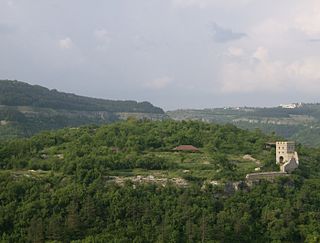
Trapezitsa is a medieval stronghold located on a hill with the same name in Veliko Tarnovo in northern Bulgaria.
Sveta gora is a hill in Tarnovgrad and was spiritual and literary center in the Second Bulgarian Empire.

The culture of Veliko Tarnovo concerns the arts, museums, festivals and other entertainment in Veliko Tarnovo, Bulgaria.

Veliko Tarnovo is a town with a historical architectural heritage. Many of the landmark buildings and bridges were destroyed by the 1913 earthquake. The town has developed architecture from four historic periods.

Varna Monastery is a large preserved early medieval monastery complex, opened near Varna, Bulgaria, with the status of a cultural monument of national importance for Bulgaria since 2015.

Ledenik is a village in Central North Bulgaria, in the Veliko Tarnovo Municipality, Veliko Tarnovo Province - near the municipal city of Veliko Tarnovo. South of the village passes the river Yantra. The name of the village comes from the fact that it was famous for its ice houses in the past.






















